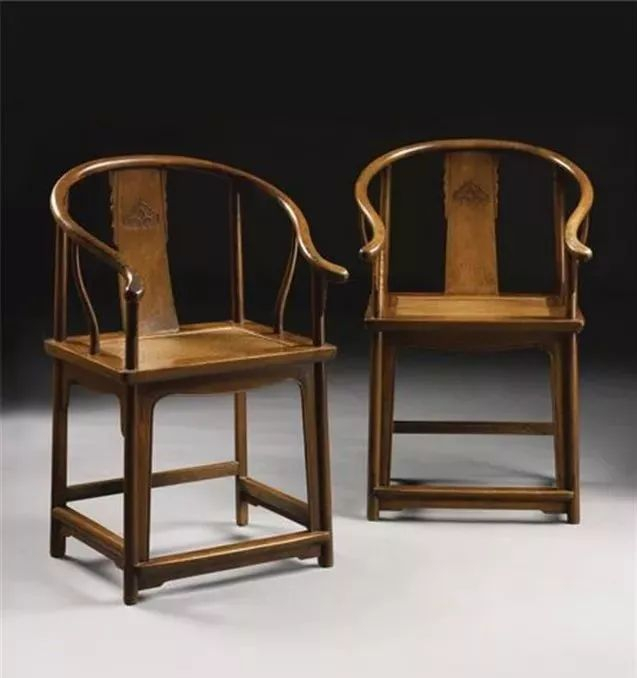Sotheby's. Fine Chinese Ceramics & Works of Art. New York, 19 march 2013
A pair of huanghuali horseshoe-back armchairs (quanyi), 17th century
Lot 484. A pair of huanghuali horseshoe-back armchairs (quanyi), 17th century. Height 36 1/2 in., 92.7 cm; Width 24 n., 61 cm; Depth 17 in., 43.2 cm. Estimate: 120,000 — 180,000 USD. Lot sold 233,000 USD. © Sotheby's
each with a well-rounded crestrail comprised of five scarf-joined members and set on straight back posts and S-shaped front and side posts, a shaped spandrel beneath each elegantly outscrolled and rounded terminal, with a rectangular splat enclosing a carved foliate cloud medallion containing entwined vegetal forms, flanked by integral beaded, shaped spandrels, the post continuing through the soft seat frame forming the legs of circular section secured by beaded aprons and four stretchers of ascending height, the footrest well-worn (2).
Property from the Collection of Miriam and Ira D. Wallach.
Provenance: Fusil Anstalt, Guernsey, Channel Islands, 5th March 1997.
Note: There are three ways to achieve bended wood; steam or heat the wood and bend it in a mold, cut a bent piece of wood or construct the bend from segments. Horseshoe-back armchairs utilize the latter technique, the first seemed to be only used with bamboo, the second is too wasteful so the third seemed the most logical method. Most horseshoe-back rails are composed of five segments although there are a few examples with three (very few remain as it would require extravagant use of expensive hardwood and is much more vulnerable to damage).
The half-lapped pressure-peg join used to create the generous graceful curve of the crest rail of the present pair of armchairs was in architectural use from the 11th century for beams, sills and lintels. Its use on a smaller form and in a highly resinous, tightly grained hardwood required the craftsman's most diligent attention. The wood must be very carefully chosen so that the grain bends with the curve in order to ensure a strong join and worked to proportions that were inviting, aesthetically pleasing and enduring.
For further discussion on the form see Curtis Evarts, 'Continuous Horseshoe Arms and Half-Lapped Pressure-Peg Joins', Journal of the Classical Chinese Furniture Society, Spring 1991, p. 14-18.

/https%3A%2F%2Fprofilepics.canalblog.com%2Fprofilepics%2F1%2F0%2F100183.jpg)
/https%3A%2F%2Fstorage.canalblog.com%2F03%2F02%2F119589%2F96711876_o.jpg)
/https%3A%2F%2Fstorage.canalblog.com%2F11%2F31%2F119589%2F94773502_o.jpg)
/https%3A%2F%2Fstorage.canalblog.com%2F20%2F83%2F119589%2F94772815_o.jpg)
/https%3A%2F%2Fstorage.canalblog.com%2F26%2F72%2F119589%2F75604929_o.jpg)
/https%3A%2F%2Fstorage.canalblog.com%2F59%2F60%2F119589%2F26458628_o.jpg)





/http%3A%2F%2Fstorage.canalblog.com%2F32%2F99%2F119589%2F129836631_o.jpg)
/http%3A%2F%2Fstorage.canalblog.com%2F46%2F82%2F119589%2F129704536_o.jpg)
/http%3A%2F%2Fstorage.canalblog.com%2F49%2F48%2F119589%2F129680938_o.jpg)
/http%3A%2F%2Fstorage.canalblog.com%2F64%2F83%2F119589%2F129635530_o.jpg)